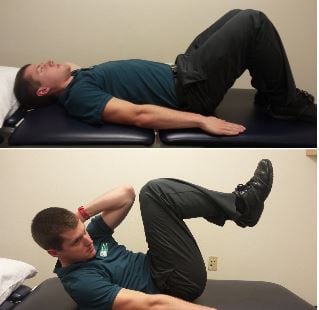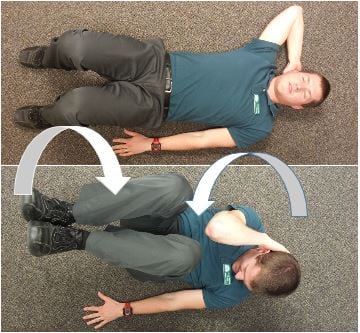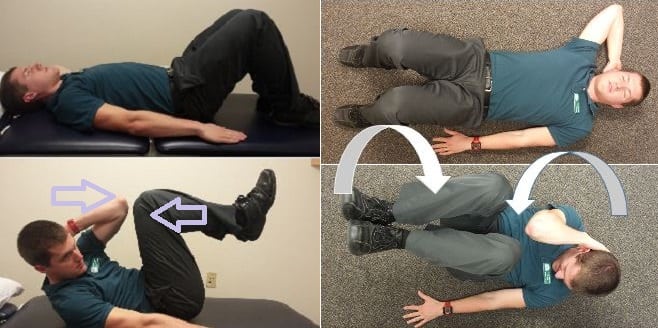 As physical therapist, I tend to cycle through a lot of exercises. Like tools, some are good for one job, and some for others. Some seem pretty good… only to eventually fail and be discarded. A few are useful for many tasks–or for many people–and become a great multi-tool. But a precious few truly stand the test of time. By proving their usefulness consistently over many years, for runner after runner, they become a sort of neuromuscular Swiss Army Knife in the repertoire.
As physical therapist, I tend to cycle through a lot of exercises. Like tools, some are good for one job, and some for others. Some seem pretty good… only to eventually fail and be discarded. A few are useful for many tasks–or for many people–and become a great multi-tool. But a precious few truly stand the test of time. By proving their usefulness consistently over many years, for runner after runner, they become a sort of neuromuscular Swiss Army Knife in the repertoire.
A handful of exercises fit this bill, and they’ve been described here before:
- My favorite running-specific push-off hip activator, the Short and Long
- My favorite stance stability exercise, the Ice Skater
- My favorite running drill, the 100-Up
The 2017 inductee to this short list is the “Diagonal Chop.” It is, to date, the best running-specific, deep-abdominal activator.
The Diagonal Chop
 The Diagonal Chop combines two pretty good abdominal exercises into one great one: a diagonal crunch with a reverse crunch. The former is fairly basic and universal: lifting the shoulders upward toward the knees, but adding a twist, angling the elbow to the opposite knee. I generally don’t like crunches (even in a diagonal) because an upper trunk and neck flexion (on its own) holds very little resemblance to anything we do when running!
The Diagonal Chop combines two pretty good abdominal exercises into one great one: a diagonal crunch with a reverse crunch. The former is fairly basic and universal: lifting the shoulders upward toward the knees, but adding a twist, angling the elbow to the opposite knee. I generally don’t like crunches (even in a diagonal) because an upper trunk and neck flexion (on its own) holds very little resemblance to anything we do when running!
A reverse crunch is less common–but arguably more running-specific. This exercise works on an upward curl of the pelvis (and with it, the legs) toward the head, while the upper trunk and arms stay flat and motionless. The utility of the reverse crunch is that it is running-specific: we want the abdominals to help facilitate the upward and forward knee and hip drive while running.
The Diagonal Chop combines these two exercises into one. In doing so, it uses a neurological phenomenon called irradiation to improve deep abdominal muscle activation. Irradiation occurs when you use a stronger, more active muscle to ‘wake up’ an adjacent muscle. This is what happens with the combined crunches in the Diagonal Chop.
To Perform
 Like a normal crunch, begin on your back with the knees bent and the feet flat.
Like a normal crunch, begin on your back with the knees bent and the feet flat.- The Diagonal Chop is one-sided. You can perform consecutive on one side or alternate sides, each repetition.
- To work on the right side, extend the right arm overhead (face level), while the left hand supports the neck.
- ‘Chop’ the right arm downward, past the hip, to the floor. Simultaneously, curl the legs and pelvis upward, knees to nose. A proper diagonal motion has the left elbow aim toward the right knee.
- Then, reach the hand forward. Reaching beyond the feet causes a trunk compression (as in a usual crunch), specific to how the abs help elevate the pelvis. Hold this for one second.
- Push the hand and arm into the floor. Like a swimming motion, push the entire arm (from the hand to the shoulder blade) into the floor. This will help elevate the legs even higher and closer to the head. While this may seem like a ‘cheat,’ this too is running-specific. A rearward swinging arm helps propel the driving leg (hip and pelvis) forward and upward. Hold the motion for one to three seconds, or as long as it takes to feel a deep widespread burn in the abs on that side.
- Lastly, very slowly open back to the floor. Control the low back, avoid letting it arch uncontrollably on the opening.
And that’s it. The Diagonal Chop, using the upper-body motion common in a crunch, then takes running specific elements of rotation, hip flexion, and pelvic elevation into the best three-dimensional abdominal activator out there.
Benefits
The central benefit of the Diagonal Chop is deep abdominal activation. By definition, activation occurs when we can consciously ‘feel the burn’ of a particular muscle group. This is a motor-control phenomenon necessary for the brain to rapidly and easily access that muscle group.
The specific group we wish to activate includes a muscle called the transverse abdominus, thought of as the most important deep (beneath the main mover) abdominal in the body. The transverse abs both hold the spine and pelvis firmly in place, when necessary, but also help to actively elevate the pelvis. When the abs help the pelvis elevate, it makes the knee and hip lift much easier and more powerfully.
The alternative to deep core activation is compensation, or worse, disuse. Failure to adequately activate the deep core muscles typically results in the body trying to use non-endurance, non-stabilizing muscles for the task. Examples of compensatory trunk stabilizing muscles include the rectus abdominus (the ‘six-pack muscle’) and the psoas (which ideally works in combination with the deep core to flex the hip). In short, compensatory-muscle recruitment results in decreased power, endurance, and overall efficiency. This is obviously not a good combination.
Like Short and Long does for the glutes, the Diagonal Chop is a crucial activator for the abdominals. Once activated, the whole system works better, including:
- Enhanced (stronger, higher) upward and forward hip drive (with more endurance)
- Better landing stability (and enhanced hip strength)
- Improved posture
When and How
The Diagonal Chop is a powerful activator that is best done pre-run, to ensure the abdominals are awake and ready to fire. Additionally, the Diagonal Chop is a good starter for any other core or strength routine. Once ‘awake,’ most conventional ab exercises–including sit-ups, bicycles, and planks–are more effective (stronger, more burn).
In fact, the Diagonal Chop was so effective when used with our high-school track team that most kids would perform it on their own, immediately pre-race, as a clutch performance enhancer. As few as five repetitions per side–feeling a strong, widespread burn–is enough to get things firing and make a huge impact on the speed, strength, and economy of your run!
Call for Comments (from Meghan)
Okay, it’s time to try the Diagonal Chop. Go ahead and do it, and then report back here in the comments section with your thoughts on it! Thanks.


